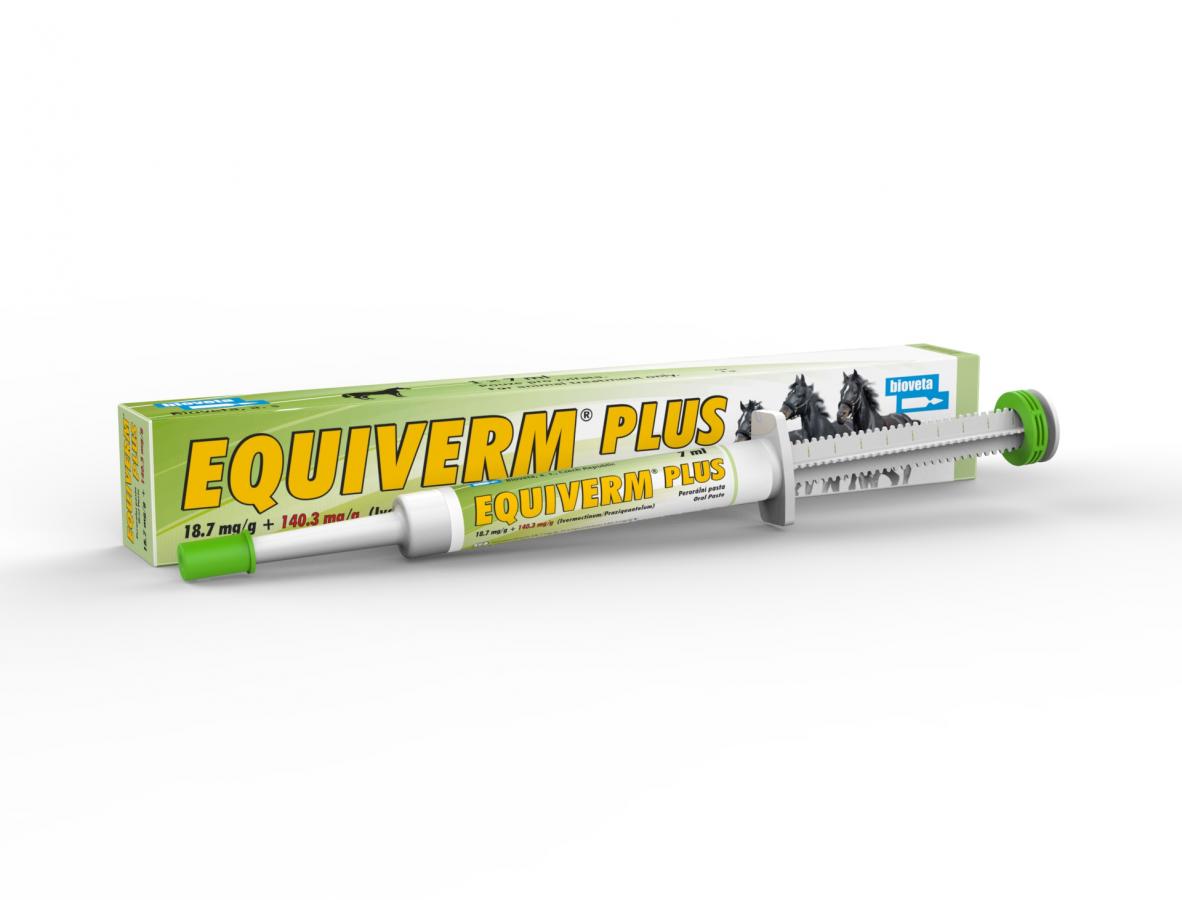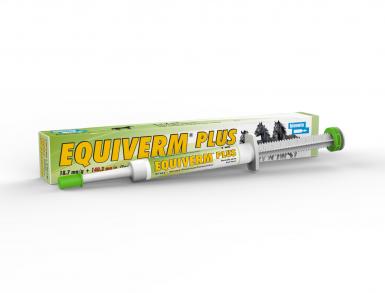EQUIVERM PLUS 18,7 mg/g + 140,3 mg/g oral paste for horses
Homepage Products Veterinary products EQUIVERM PLUS 18,7 mg/g + 140,3 mg/g oral paste for horses
Oral paste (ivermectinum/praziquantelum) for treatment of parasitic diseases in horses
| type of preparative: | Antiparasitics |
|---|---|
| target species animals: | Horse |
Each gram of paste contains:
Active ingredients:
Ivermectinum 18,7 mg.
Praziquantelum 140,3 mg
Green paste with a characteristic apple and cinnamon aroma.
Target animal species
Horses
Indications for use
Treatment of mixed infestations of cestodes and nematodes or arthropods caused by adult or developmental stages of nematodes, lungworms, hookworm larvae and tapeworms in horses.
This veterinary medicinal product is indicated only if concomitant use against hookworms, fluke larvae and tapeworms is indicated.
Parasites:
Large strongylids:
Strongylus vulgaris (adults and L4 arterial larval stages)
Strongylus edentatus (adults and L4 tissue larval stages)
Strongylus equinus (adults)
Triodontophorus spp. (adults)
Small strongylids:
Cyathostomum spp., Cylicocyclus spp., Cylicostephanus spp., Cylicodontophorus spp., Gyalocephalus spp. (adults and uninhibited mucosal larvae)
Parascaris: Parascaris equorum (adults, larvae)
Oxyuris: Oxyuris equi (larvae)
Trichostrongylus: Trichostrongylus axei (adults)
Strongyloides: Strongyloides westeri (adults)
Habronema: Habronema spp. (adults)
Onchocerca: Onchocerca spp., tj. cutaneous onchocercosis
Plicnivky: Dictyocaulus arnfieldi (adults, larvae)
- Tapeworms: Anoplocephala perfoliata (adults)
- Botflies: Gasterophilus spp. (larvae)
Contraindication
Do not use in foals under 2 weeks of age.
Do not use in case of hypersensitivity to the active substances or to any of the excipients.
Special warnings
The product can be used in stallions.
Unnecessary use of antiparasitics or use deviating from the instructions given in the SPC may increase the resistance selection pressure and lead to reduced efficacy. The decision to use the product should be based on confirmation of the parasitic species and burden, or of the risk of infestation based on its epidemiological features, for each group of animals.
Repeated use for an extended period, particularly when using the same class of substances, increases the risk of resistance development. Within a herd, maintenance of susceptible refugia is essential to reduce that risk. Systematically applied interval-based treatment and treatment of a whole herd should be avoided. Instead, if feasible, only selected individual animals or subgroups should be treated (targeted selective treatment). This should be combined with appropriate husbandry and pasture management measures. Guidance for each specific herd should be sought from the responsible veterinarian.
Partial cross-resistance between ivermectin and moxidectin has been reported. Furthermore, resistance to ivermectin (an avermectin) has been reported in Parascaris equorum in horses in a number of countries including the EU. Therefore, the use of this product should take into account local information about susceptibility of the target parasites, where available. It is recommended to further investigate cases of suspected resistance, using an appropriate diagnostic method (e.g. Faecal Egg Count Reduction Test). Confirmed resistance should be reported to the marketing authorisation holder or to the competent authorities.”
Tapeworm infestations are rare in foals before 2 months of age, therefore treatment of foals younger than 2 months of age is not considered necessary.
Special precautions for use
Special precautions for safe use in the target species:
Avermectins may not be well tolerated in all non-target species. Cases of intolerance have been reported in dogs, especially collies, Old English Shepherd dogs and related breeds or their crossbreds, as well as in turtles and tortoises. Dogs and cats should not have access to paste residues or used applicators due to the possibility of side effects associated with ivermectin toxicity.
Special precautions to be taken by the person administering the veterinary medicinal product to animals:
People with known hypersensitivity to ivermectin, praziquantel or any of the excipients should avoid contact with the veterinary medicinal product. This product may cause skin and eye irritation. Avoid contact with skin and eyes. In the case of accidental contact with skin or eyes wash the affected area immediately with plenty of water. If skin or eye irritation persist, seek medical advice. In the case of accidental ingestion, especially by a child, seek medical advice immediately and show the package leaflet or label to the physician. Personal protective equipment consisting of gloves should be worn when handling the veterinary medicinal product, especially for multiple use of the product. Do not eat, drink or smoke while handling the product. Wash hands after use.
Special precautions for the protection of the environment:
The product is very toxic to aquatic organisms, therefore treated animals should not have direct access to ponds, streams or ditches for 14 days after treatment. The product is very toxic to dung fauna and long term effects on dung insects caused by continuous or repeated use cannot be excluded. Therefore, repeated treatment of animals on a pasture with an ivermectin-containing product within a season should only be given in the absence of alternative treatments or approaches to maintain animal health, as advised by a veterinarian.
Adverse events
Horses:
|
Very rare (< 1 animal / 10,000 animals treated, including isolated reports): |
Anorexia1 Colic1, Diarrhea1, Allergic reaction (such as allergic oedema3, congested mucous membrane, hypersalivation, tachycardia, tongue oedema,urticaria) |
|
Undetermined frequency (cannot be estimated from the available data) |
Itching2 Swelling2 |
1 especially in the case of severe parasitic burden
2 after treatment of horses with severe Onchocerca microfilariae infestations. These reactions are probably caused by the killing of a large number of microfilariae.
3subcutaneous
If these signs persist, contact your veterinarian immediately. Reporting adverse events is important. It allows continuous safety monitoring of a veterinary medicinal product. Reports should be sent, preferably via a veterinarian, to either the marketing authorisation holder or its local representative or the national competent authority via the national reporting system. See the package leaflet for respective contact details.
Pregnancy and lactation
Can be used during pregnancy and lactation.
Administration routes and dosage
Oral use. Single administration of 200 µg of Ivermectin and 1.5 mg of praziquantel per kg bw, equivalent to 1.07 g of the paste per 100 kg of body weight. To ensure correct dosing, it is necessary to determine the most accurate weight possible and to measure the appropriate dose to prevent underdosing which may increase the risk of developing anthelmintic resistance.
|
Horse weight |
Paste dose |
Horse weight |
Paste dose |
|
Up to 100 kg |
1.070 g |
401–450 kg |
4.815 g |
|
101-150 kg |
1.605 g |
451-500 kg |
5.350 g |
|
151-200 kg |
2.140 g |
501-550 kg |
5.885 g |
|
201-250 kg |
2.675 g |
551-600 kg |
6.420 g |
|
251-300 kg |
3.210 g |
601-650 kg
|
6.955 g |
|
301-350 kg |
3.745 g |
651-700 kg
|
7.490 g |
|
351-400 kg |
4.280 g |
|
|
The first portion of the paste is sufficient to treat animals weighing 100 kg bw. Each additional division of the applicator will provide a sufficient volume of paste for 50 kg bw. Set the applicator according to the calculated dose by moving the ring to the corresponding mark.
An applicator containing 7.49 g of paste will provide enough paste to treat a horse weighing 700 kg at the recommended dosage.
Instructions for use
Before administration, set the applicator according to the calculated dose by moving the ring to the corresponding mark. The paste is administered orally through the interdental space to the root of the tongue. The animal’s mouth should not contain any food residue. Immediately after administration, raise the horse’s head for a few seconds to ensure that the dose is swallowed properly.
In order to achieve an adequate level of prevention against infection with tapeworms and roundworms, it is necessary to provide veterinary consultancy on appropriate dosing and stock management.
Symptoms of overdose (and where applicable, emergency procedures and antidotes)
A tolerance study performed in foals over 2 weeks of age at 5 times the recommended doses did not show any side effects. Safety studies performed at 3 times the recommended doses of the veterinary medicinal product in mares at 14-day intervals throughout pregnancy and lactation did not reveal miscarriages, any adverse effects on pregnancy, parturition and general health of the mares, nor any abnormalities on the foals.
Safety studies performed at 3 times the recommended doses of the veterinary medicinal product in stallions did not show any adverse effects, especially on reproductive performance.
Withdrawal periods
Meat and offal: 35 days. Not authorised for use in animals producing milk for human consumption.
Environmental properties
Ivermectin is very toxic to aquatic organisms and dung fauna. Like other macrocyclic lactones, ivermectin has the potential to adversely affect non-target organisms. Following treatment, excretion of potentially toxic levels of ivermectin may take place over a period of several weeks. Faeces containing ivermectin excreted onto pasture by treated animals may reduce the abundance of dung feeding organisms which may impact on the dung degradation.
Shelf life
Shelf life of the veterinary medicinal product as packaged for sale: 18 months
Shelf life after first opening the immediate packaging: 6 months.
Special precautions for storage
Store below 25 °C. Store in a tightly closed applicator. After use, replace the cap again.
Do not refrigerate or freeze.
Packaging
7 ml multi-dose applicator made of white high-density PE with scale printed HDPE piston, PP dosing ring and HDPE cap. The applicator contains 7.49 g of product and is equipped with an adjustable dispenser.
Box with 1 or 10 applicators.










